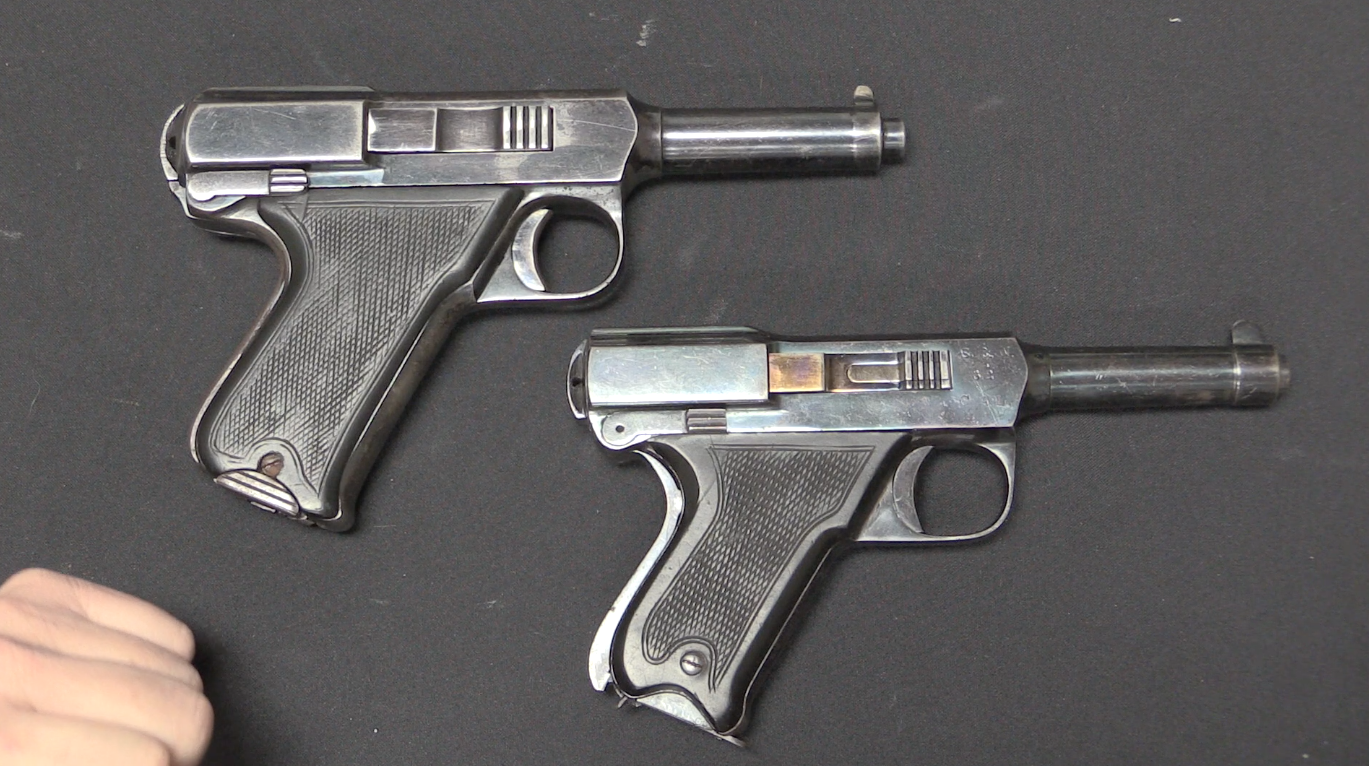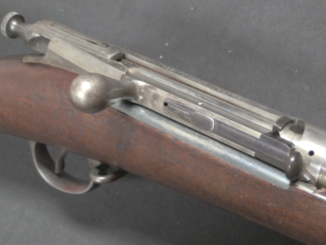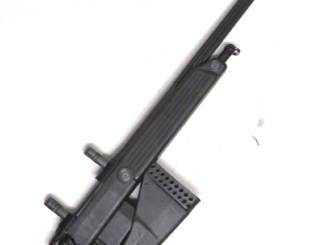The Cochran turret revolver is one of the more common turret revolvers in the US, although that’s a pretty low bar, as only about 150 of them were made. Turret-sytle revolvers never became popular on the commercial market because of the potential hazards posed by a chainfire when one has chambers pointing in all directions – including back at the shooter.
Related Articles

Prototype
RIA: Reifgraber .38 S&W Automatic

Bolt Action Rifles
Chaffee Reece Model 1882: A Good Idea on Paper…

Uncategorized

You sure find and describe some strange and crazy forgotten weapons. Keep up the good work and digging deeper.
Turret revolvers are never a good idea in hindsight, especially since the chambers need to be machined out of that turret block. Any misalignment and a regular discharge will destroy the frame without a chain-fire incident.
Don’t forget the fact that you or your allies could be hit if one of the cylinders went off prematurely.
See if you can do a special on his cannons. Even diagrams should help explain them.
See Weel spoke:
http://littlegun.info/curios%20et%20antiquites/a%20weel%20spoke%20gb.htm
– variation about turret revolver, but with wheel vertically and bullets launched inside wheel. Usefulness is dubious, considering capacity: 3
Here is a photo of the Cochran turret cannon in Turkey on display without it’s carriage if it had one, might have been designed for fixed fortificaion? Looks like a three shot gun.
http://www.go2gbo.com/forums/blackpowder-mortar-and-cannon-sponsored-by-seacoast-artillery/multi-shot-ordnance/
Looks to be all bronze?
The only really successful “turret revolvers” were the Turbiaux type “palm squeezers”, aka the “Chicago Palm Pistol”, made in Europe in 5mm and 6mm mostly, and in this country in .32 S&W. These of course were metallic cartridge arms and so did not have multiple discharge to worry about.
There are actually some notable safety features in the Cochran. For instance, the odd number of chambers (7) means that when one is in line with the barrel, there is no chamber pointed straight back; rather, two are pointed at about 5 and 7 o’clock, as seen from above or below. Which incidentally puts them in back of those two “wings” on the sides of the frame.
Also, the holes for the cylinder locking pin on top are between the chambers, not over them. So they are not a weak point in a chamber wall.
The manual of arms for this would almost mandate a “modern” two-hand hold. The off hand would have to rotate the cylinder and cock the hammer for each shot. Significantly clumsier than a conventional Colt-type single-action revolver.
On the other hand, with pre-loaded spare “drums”, it could be reloaded about like an Adams or Remington revolver with pre-loaded spare cylinders. Only a modern autoloader with box magazines would be much faster.
Cochran’s adventure with the sultan is not that unusual, actually. The Ottomans had a tradition of hiring foreign armaments experts to build and operate their artillery.
In fact, when the Turkish sultan Mehmed II besieged and took Constantinople in 1453, the guns he used to destroy the outer ramparts and open the way for his (Christian) Janissaries to swarm over the walls and open the gates were cast and commanded by a Hungarian gun expert named Urban.
I’ve often thought that the ideal use for a “turret gun” would have been in a graveyard, back in the days of the “resurrectionists”. Have a monument with, say, a 20 or 30-barreled “turret gun” concealed in it, just above the level of most of the tombstones. Run thin cords dyed black, like fishline, to various places that Messrs. Burke and Hare are likely to be getting busy, hooked to a sort of “all-ways” trigger like on the old Chinese seismograph.
A spring-loaded ring, held cocked by the trigger against a powerful coil spring (like a modern car suspension spring), is released when any of the cords is tripped. It slams upward against the ring holding the caps in place, forcing it upward, and firing all caps- and all barrels– simultaneously.
Next morning, the magistrate’s runners can collect the body snatchers. What’s left of them, anyway.
If a turret setup is prone to multiple discharges, at least this way they could have bee put to some effective (if gruesome) use.
cheers
eon
Yikes. Scary way to use a chain-fire. I drew up a crazy idea back in high school where a rigged up MG08 would fire in a preset arc if the door to a house were kicked through. Even if the door were kicked off its hinges, the trap would be triggered, spraying the intruder. No, I never built the trap, but it was for a murder mystery I was thinking of writing…
If it interests you, I think I have an article somewhere from the American Rifleman magazine on the illegality of “set guns”; guns rigged to blast an intruder.
The whole point of making “set guns” illegal is that the traps can kill people who are authorized to bust down the door, like cops and fire-fighters. And, of course, it’s pretty dang overkill and inhumane to reduce robbers and burglars to hamburger without the house owner actually having been put in danger in the first place. I mean, seriously, we are not stuffy English Lords dealing with armed and dangerous poachers, so we have no need for trip-wire-fired spring guns…
Actually, the Chicago palm pistols were chambered in .32 extra-short rimfire, NOT .32 S&W.
I bet being a favorite at the Ottoman court would have been quite the party. Looking at what Eon just posted and looking over the “turret cannon” designs that Cochran sold in Turkey, it seems as though the “chain fire” problem may have been overstated a bit with the turret designs. I wonder if there is any actual contemporary evidence of this occurring with any frequency on turret weapons, especially if properly loaded with the chambers sealed and greased. In my pepperbox “experiments” many years ago, I was able to recreate the “chain fire” occasionally, and even with the most unsafe loadings (no wads, grease, loose powder grains/residue)it wasn’t too frequent an occurrence. Of course, with a pepperbox it was all good fun, but unfortunately for the turret designs, even a theoretical risk of shooting oneself in the head (or in the case of the cannons, taking out the neighboring gun crew) is more than enough reason to look for an alternative design. A percussion version of Puckle’s gun with pre-loaded cylinders would have had some potential, I suppose.
To me, the problem to me as a customer would not be chain firing but how to carry the darn thing.
A holster for this would probably look a lot like a scabbard for a wide-bladed trowel type bayonet. A narrow, triangular “pouch” with a deep, wide “V” cut on the side away from the belt.
The pistol would be carried with the butt pointed outward at right angles to the belt, the “turret” parallel to the belt and flat against the hip, more or less.
The draw would start with the gun hand and arm hanging relaxed, palm backward, back of hand toward target. A straight upward movement plus curling the fingers would bring the gun hand into contact with the grip.
The gun would be pulled straight up, then the shoulder rotated forward to bring it into line. In the process, the wrist would be rotated to bring the gun upright.
By this time, the off hand should be up and under the gun to bring the hammer to full cock and then cup the butt in a modified Weaver address.
Actually, it’s basically a cavalry-style “twist draw” with a bit less wrist action required.
NB: Since the off hand is necessary to recock and turn the turret, this is definitely not a gun for anyone wanting to emulate Bill Hickok’s two-gun technique. Stick to a Colt or Remington for that.
(It never even worked too well with a S&W, due to the forward “reach” necessary to recock the hammer on that one.)
😉
cheers
eon
Yes, but you have the butt sticking out to the side, still not convenient. You can’t even put it in many wooden drawers if you are a shopkeeper. In short it is impossible to conveniently wear or conceal on the person or near you. Certainly the advantage of having more than one shot is a good thing, but the inconvenience outweighs the advantage and to me that is why the idea most probably fails you can conceal two or three single shot pistols in the same space as a turret pistol. The there were vertically mounted “turrets like the spokes of a wheel and at least those weapons could be worn on the person or in holsters discreetly, the palm pistol coming to mind.
Apart from the wonky turret cylinder, this looks like a well thought out and manufactured firearm, especially considering it is approaching its 200 birthday.